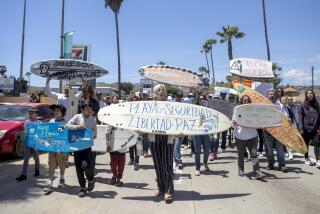Fighter Pilots Seek Opponents for an Endgame
After 75 days, the air war in Afghanistan has been honed to a relentless rhythm of round-the-clock missions in search of the few remaining targets.
In pilot jargon, the campaign is now reactive rather than preemptive. Pilots endure the roar of the flight deck for the hours-long flight to Afghanistan not knowing whether the air controllers on the ground will find targets for them.
The large targets--Taliban military installations, Al Qaeda training camps--have been destroyed, but pilots and squadron commanders aboard this nuclear-powered carrier say they want to send the message that resistance is futile and that terrorists are subject to attack at any hour of the day or night.
Although the quantity of targets has declined, the importance of the remaining ones has increased, and the zeal to be the pilot who unleashes the ordnance that kills or runs to ground a major figure is intense.
“We’re out of traditional infrastructure targets,” said Capt. R.C. Thompson, an F/A-18 Hornet pilot and commander of the Stennis air wing, “but there are still cells of Taliban and Al Qaeda on the ground. I’d love to be the one to take out [Osama] bin Laden or [Mullah Mohammed] Omar or any of the senior leadership.”
Part of this endgame is psychological. Jets often fly at an altitude designed to leave a contrail, a reminder of their lethal presence. If a Taliban or Al Qaeda survivor ventures from a cave at Tora Bora or another hide-out, U.S. officials say they want him to be aware of the planes.
“I want [Taliban and Al Qaeda] always hearing jet noise,” said Thompson, 46, a Minnesota native and veteran of combat missions in the Persian Gulf War and Operation Southern Watch, enforcing a “no-fly” zone in Iraq. “I want them to know if they poke their head out of their cave, they’re going to get whacked.”
To keep a 24-hour presence in the sky over Afghanistan, the Stennis and carrier Theodore Roosevelt have divided the shifts into day and night. The San Diego-based Stennis, which arrived here Dec. 15, drew the night duty, which means pilots sleep during the day and fly at night.
For the 5,000 sailors and Marines aboard the Stennis, it means a topsy-turvy existence, with breakfast at 6 p.m., dinner at 6 a.m. and midday rations at midnight. The ship’s chaplains give the nightly prayer at 11 a.m., just as most of the crew is turning in.
Not even Christmas will keep the carrier’s 70 warplanes from flying their daily average of 80 sorties.
“It would be a disservice to the special operations guys and the Marines on the ground sitting in tents and bushes and watching out for bad guys, if the carrier took a day off, even for Christmas,” said Cmdr. Jeffrey Miller, 43, of Media, Pa., the ship’s executive officer.
Rushed to the Arabian Sea two months ahead of schedule, some pilots find the constant search for targets frustrating. Planes often return to the carrier without having been able to drop any bombs. Concerns about hitting civilians or noncombatants often require pilots to forgo possible targets.
“It’s like we got all dressed for the prom, but we got there just as everybody was leaving,” said Marine Capt. Tom Clarkson, 29, from Jacksonville, Fla., an F/A-18 pilot from the Black Knights squadron at Miramar Marine Corps Air Station in San Diego.
“Peace is breaking out all over, who could have figured?” said “Boxhead,” a radar-intercept officer on an F-14 Tomcat.
But when a plane does return after a bombing mission, a jolt goes through the crew. “When you see a plane come back without any ordnance, it’s an awesome thing,” said airman Tammy Smith, 20, of Joplin, Mo.
The Stennis had not been scheduled to leave San Diego until early January for a six-month deployment in the Persian Gulf, enforcing the Iraqi no-fly zones and maritime restrictions. It was ordered to deploy early to relieve the carrier Carl Vinson, which has carried the brunt of the air war since it began Oct. 7, and to keep a two-carrier presence in the Arabian Sea.
In one sense, the Vinson and Stennis are mirror images. The Vinson was in the region Sept. 11, so its crew was not witness to the fear and confusion spread in the U.S. by the terrorist attacks. The Stennis was off San Diego on a training mission when the World Trade Center and Pentagon attacks occurred. It provided protection off the Southern California shore for several days, then the crew spent several weeks ashore preparing for the current deployment.
Although three months have passed since the attacks, the sense of outrage is fresh among crew and air squadron members. “I was chomping at the bit to make amends for what happened,” Clarkson said. “I would have left Sept. 12 if I could have.”
Thompson has painted a small portrait of a moose on his F/A-18 Hornet, a homage to his friend “Moose” Sweeney, who was aboard one of the hijacked planes. Sweeney was an instructor at the Top Gun school in San Diego when Thompson was the commanding officer. Many of the F-14 pilots have removed their names from their planes and substituted those of New York police and firefighters killed in the World Trade Center collapse.
Ordnance workers are chalking messages on the bombs destined to be dropped on the caves at Tora Bora or any other Taliban or Al Qaeda hide-out. “Look what you’ve won, Osama,” says one.
“I’m not a warmonger,” said “Shooter,” an F-14 pilot from the Checkmates squadron at Oceana, Va. “But I want some payback.”
Although the Stennis may have reached the Arabian Sea as the bombing has decreased, it could be well positioned if the war spreads.
“I tell our people: We’ve had good success so far, but there’s still a lot of work to do,” said Rear Adm. Jim Zortman, commander of the Stennis battle group. “These [terrorist] networks have worldwide reach and connections and that leads me to believe there are other locations where this war is going to be fought.”
More to Read
Start your day right
Sign up for Essential California for news, features and recommendations from the L.A. Times and beyond in your inbox six days a week.
You may occasionally receive promotional content from the Los Angeles Times.




